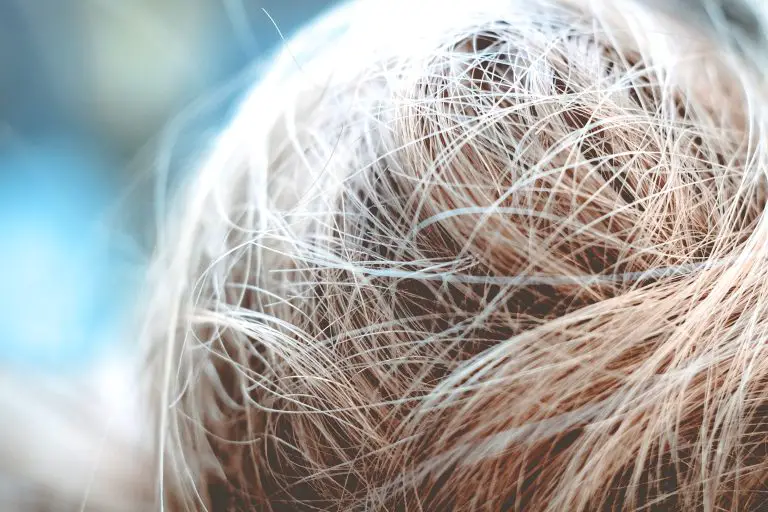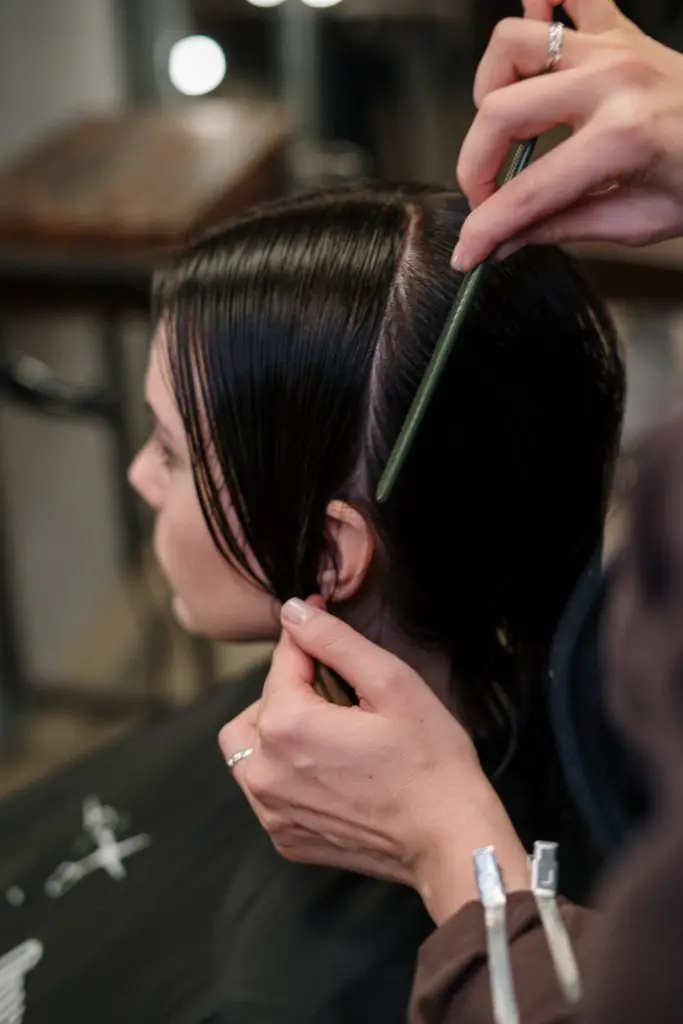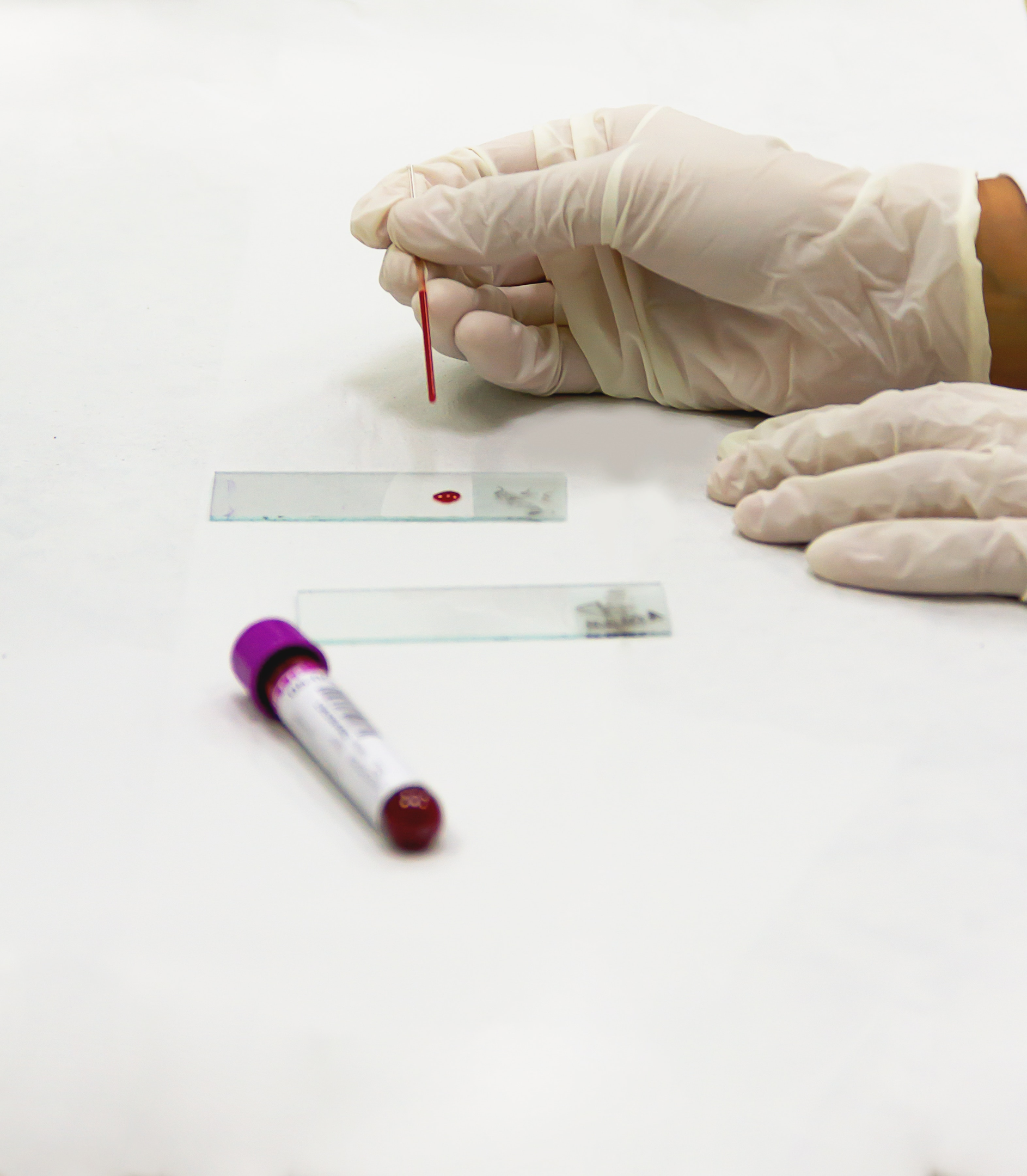
Page Contents
If you have diffuse thinning of your hair, it can be very hard to notice at first. Sometimes the only thing you will notice is that your hair doesn’t take up as much of your hand when you pull it into a ponytail.
Since diffuse thinning can sneak up on you gradually, it can be equally hard to determine what is causing your hair loss. So, let’s look at what the causes of diffuse hair loss are, some ways diffuse hair loss is diagnosed, and what you can do about diffuse thinning.
Signs Of Diffuse Thinning
Diffuse thinning can eventually lead to complete hair loss, which is why you should try to catch it as early on as possible. There are four main signs you can look for.
First of all, your scalp is more easily visible. As your hair density decreases, your scalp won’t be covered as well by your hair strands.
Secondly, you’ll start to notice excessive shedding. You are probably used to seeing a certain amount of hair on your brush or in your drain. With diffuse thinning, you will see this amount increase.
Third, styling your hair will be different. As mentioned, you’ll notice less hair in your ponytails. Also, your braids will seem smaller, and you may notice other changes as well.
The last sign of diffuse hair loss is when it starts to get more obvious. This usually involves a receding hairline or areas of your scalp where there are no hairs left.
What Are The Causes Of Diffuse Hair Loss?
When you have diffuse hair loss, there are sometimes no other signs to help you determine what is causing it. Fortunately, most causes of diffuse thinning come with other side effects that will help.
Pattern Hair Loss
Pattern hair loss is an incredibly common cause of hair loss. The American Academy of Dermatology Association (AAD) says female pattern hair loss tends to start at your part line and around your temples.
Female pattern hair loss then transitions to widespread thinning. Meanwhile, male pattern baldness tends to occur in certain areas like the forehead and temples first, rarely being diffuse over your whole scalp.
The medical term for male and female patterned hair loss is androgenetic alopecia. It can happen rapidly or slowly and often eventually causes complete baldness in men.
Alopecia Areata
Alopecia areata is one of a few autoimmune disorders that can attack your hair follicles. This usually causes hair loss in clumps somewhere on your scalp. Diffuse alopecia areata is more uncommon but still possible. The AAD lists three types of alopecia areata:
Alopecia Areata
Alopecia Totalis
Alopecia Universalis
The first is the hair loss in patches most commonly associated with alopecia areata. The second is hair loss over your entire scalp, with the third type being hair loss over your whole body.
There is a fourth type, called alopecia areata incognita, which the International Journal of Women’s Dermatology talks about here. This causes diffuse alopecia areata, which is often much harder to diagnose due to not causing clumping hair loss like the other types. Other symptoms of this include your nails spitting and thinning, a burning sensation on your scalp, etc.
Other immune conditions can also be bad for your hair growth. For example, the Lupus Foundation of America lists hair loss as a possible symptom of lupus. Systemic lupus erythematosus tends to be the worst lupus condition for your hair.
Psoriasis most often affects your skin, but it can also cause hair loss. Chron’s disease negatively impacts your digestion and can cause you to be deficient in the vitamins you need for your hair.
Telogen Effluvium
Telogen effluvium is named that because your hair falls out during the telogen phase of the hair cycle. In the telogen phase, the hair follicle is supposed to keep holding onto the hair strand while the follicle rests.
Telogen effluvium can be caused by many things, but it is mostly related to extreme stress. Both physical and mental stress can cause telogen effluvium, as both make the stress hormone that interferes with your hair’s cycle.
Some emotional stress examples that have been known to cause this type of diffuse hair shedding include a tough deadline at work, the loss of a loved one, or a traumatic event.
Physical stress includes things like a severe illness, an injury, or a major surgery. The longer your stress lasts and the worse it is, the more hair you are likely to lose. Fevers, infections, and crash diets can also trigger telogen effluvium by causing physical stress.
Telogen effluvium will often wait until your hair hits the resting phase, so it is months after the event before you start experiencing diffuse thinning because of it.
Anagen Effluvium
Unlike telogen effluvium, which happens in the telogen phase, anagen effluvium happens in the anagen phase. Your anagen hairs are in your growth phase and never fall out unless there are problems.
The common causes of anagen effluvium are cancer treatments, namely radiation therapy and chemotherapy. Heavy metal poisoning can also damage your hair follicles enough to cause this.
Medical Conditions
Chronic renal failure, liver failure, endocrine disorders, thyroid problems, and other things can all directly or indirectly cause hair shedding. They can do this by affecting your hormones, causing a lack of blood to your scalp, damaging your hair follicles, etc.
Unfortunately, certain medications can also cause hair thinning as a side effect. These include antibiotics, acne treatments, antidepressants, and more.
Each one will cause diffuse thinning in a slightly different way, possibly even causing bald patches. This can either affect our anagen hair or telogen hairs, depending on how severe and rapid the damage is.
Hormone Changes
There are many reasons for hormone levels to change in women. A few common reasons include:
Hormonal birth control
Pregnancy and childbirth
Menopause
Aside from those, sometimes a woman’s hormonal changes happen for no apparent reason whatsoever. Any changes in your hormones can affect your hair cycles and can cause hair thinning.

How To Diagnose Diffuse Hair Loss
Since many types of diffuse thinning are similar, getting the right diagnosis can be hard. Fortunately, your doctor has many tools at their disposal to help determine why you have excessive hair shedding.
Be patient with figuring this out, however, as it is easy for even a professional to misdiagnose. It is also possible there could be more than one reason you have excessive hair shedding.
For example, female pattern hair loss usually happens around menopause, which is also when a woman’s hormones are likely to be out of balance, potentially making it very difficult to determine which one you have. You may also have both types of hair loss.
Asking Questions
Your dermatologist will most likely start by asking some questions while they look at your hair. One thing they are sure to ask you is if you have any other symptoms besides hair loss.
They will also ask you about your stress levels to determine if you might have telogen effluvium. They will also ask you about your family’s history of hair loss. Genetic predisposition can play a large role in making you more likely to have thinning hair.
Male and female pattern hair loss is probably the most common cause of hair loss caused by hereditary factors. Alopecia areata is also slightly hereditary, as are the heart conditions that can also cause diffuse alopecia.
Physical Examination
During your scalp examination, the dermatologist will see if there are any specific areas where your diffuse alopecia is more concentrated.
For example, if the crown of your head is the worst spot and you suspect a receding hairline on the edges of your forehead, male pattern baldness is likely the culprit.
A dermatologist will look for any signs of redness, irritation, swelling, or scarring. They will also search for any vellus hairs, as this will give a clue as to what is causing the diffuse alopecia.
Pull Test
A hair pull test of your hair serves more than one purpose. First, there are a certain number of hairs that should come out. If more than this amount comes out during the hair pull test, it is a clear sign of diffuse thinning.
It also gives the dermatologist some of your hair so they can examine the hair shaft under a microscope. Depending on what the hair root looks like, it can be obvious what is causing your diffuse thinning.
Hair lost during the anagen phase, for example, has a very specific appearance with a spindle-shaped root. Meanwhile, telogen hairs have a club-shaped root end. This is actually the main way anagen effluvium is diagnosed.
Blood Tests

There are many blood tests that can be done to help narrow down the possible cause of your hair loss. For example, it is thought that chronic telogen effluvium occurs due to a lack of iron.
So, you will be tested for iron deficiency, and your complete blood count will be measured to make sure your body is making enough blood.
Vitamin B12, zinc, selenium, and folic acid levels are usually tested, as a nutritional deficiency in any of these can cause hair loss. Liver and thyroid function tests are also done, as these can affect hair growth.
Women are often given a hormonal evaluation to see if their diffuse thinning is because their hormones are off-balanced in some way.
Scalp Biopsy
Scalp biopsies, also called punch tests, take a pencil-sized area of your scalp for testing. This will allow your doctor to examine the roots of your hair for any abnormalities.
Diffuse alopecia areata will show here, and any suspicious scarring can be seen. These can provide clues as to what is affecting your scalp hair.
The Treatment Options For Diffuse Hair Loss
There are almost as many treatment options for diffuse thinning of hair as there are causes of it. Some of these are more effective than others, and a few can cause diffuse thinning instead of helping your hair.
Unfortunately, sometimes it is just a matter of waiting for your hair to grow back. Telogen effluvium, for example, usually resolves itself within a few months as your hair growth cycle resumes.
Topical Minoxidil
Minoxidil can be very effective for male and female pattern hair loss conditions. It is one of the few FDA-approved treatments for male pattern hair loss recommended on the AAD site. It is also a hair growth product I recommend to stimulate hair growth.
This helps androgenetic alopecia by increasing the blood flow to your scalp, which is helpful for many causes of hair loss. There is a different minoxidil solution for men and women, with the women’s solution being less concentrated.
Low-Level Laser Therapy
Low-level laser therapy (LLLT) can help your hair, often covering your entire scalp by using the common shape of a cap. The National Library of Medicine says it is safe and effective for diffuse alopecia. Hair grows as the lights stimulate your follicles.
Scalp Cooling
Scalp hypothermia, a.k.a. scalp cooling, is an option primarily for people going through some form of chemotherapy. Like you might guess from the name, it involves cooling down the scalp.
This is done with icepacks or something similar and can greatly reduce the amount of hair you lose. This is because the cold makes your body move your blood supply away from your hair follicles, which protects them a little from the chemotherapy process.
Treat The Underlying Cause
If there is an underlying cause affecting your hair health, it is important to do something to solve it. You will likely not get healthy hair until you solve the cause. For example, if your hair loss is because of nutritional deficiencies, you should take the necessary vitamin to correct this.
Also, if your hair loss is because of a thyroid problem, you should take whatever medications your doctor prescribes to treat your thyroid problem. The same goes for any other medical condition causing your hair loss.
Follow Hair Care Rules

Even the AAD site agrees that tight hairstyles that pull your hair too much can lead to thinning. They give seven tips on how to avoid this.
You should also avoid harmful chemicals that could make your hair loss worse. Hair growth shampoos and other products that are meant to restore hair can help with treating hair loss.
Final Thoughts
You should always measure your hair growth, preferably with periodic pictures, even if you are certain your hair is healthy. This can be helpful for catching diffuse hair loss as early as possible, which will make it easier to get hair regrowth and prevent permanent hair loss.
If you’ve had any type of diffuse alopecia, how long did it take to notice the signs? If you’ve grown your hair back since then, what hair growth products did you like the best to promote hair growth?






